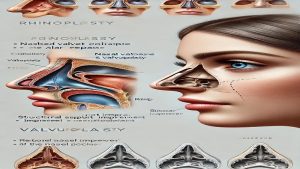Correction of nasal appearance and valve problems (Improve breathing)
Introduction
- ÿ±ğåŸÜŸàŸæŸÑÿßÿ≥ÿ™ğå (Rhinoplasty) One of the most common cosmetic and functional surgeries is to modify the appearance of the nose and improve respiratory function.. In many cases, respiratory problems caused by nasal obstruction due to structural abnormalities such as nasal blade deviation (ÿ≥Ÿæÿ™ŸàŸÖ), The size of the nose's tentacles (Turbines) Or problems related to nasal valves. In such circumstances, in addition to rhinoplasty, valloplasty (Valve Surgery) It is also performed as a supplement to improve respiratory function. In this article from the site of Dr. Behnam Khorrami (Isfahan nose surgeon _ Jaw surgeon of Isfahan), Follow these two surgical methods, applications, techniques and expected results.
1.. Anatomy
(A)) The overall nose structure
The nose consists of three main parts:
- Bone section: Includes the nasal bones and the upper part of the septum
- The cartilage section: Includes upper and lower lateral cartilage
- Soft section: Includes the skin, mucosa and soft tissue
(B)) Nasal valves
Nasal valves are divided into two parts:
Inner valve (Internal Nasal Valve):
The crossing of the upper lateral cartilage and the nasal septum
The thinnest part of the airflow in the nose
Key role in adjusting airflow
External valve (External Nasal Valve):
Communication Tip of the nose And nose blades
Its function depends on the strength and position of the lower lateral cartilage
Any defects or weaknesses in these structures will cause air route blocking, reduced air flow and respiratory problems..
2.. ÿ±ğåŸÜŸàŸæŸÑÿßÿ≥ÿ™ğå (Rhinoplasty)
(A)) Definition and application
Rhinoplasty is a surgery aimed at modifying the form and function of the nose. This surgery can include nasal resize, nasal remedies, nasal tip correction, narrowing nose width, and improving it with other facial components..
(B)) Types of rhinoplasty
Open rhinoplasty (Open Rhinoplasty):
Creating a cut in the clomella area (Tissue)
Suitable for sophisticated reforms
The possibility of direct viewing of the internal structures of the nose
Closed rhinoplasty (Closed Rhinoplasty):
Creating internal cuts without external cuts
The shorter recovery period
Suitable for minor reforms to average
ÿ¨) Rhinoplasty surgery
Anesthesia: Commonly used in general anesthesia.
Cutting: Depending on the type of surgery, appropriate incisions occur.
Structure correction:
Shaving or strengthening the bone and cartilage
Reconstruction or change of position of nasal valves
Close cutting: The cuts are closed with delicate sutures.
Plastering or splint: To fix the new nose structure
ÿØ) Rhinoplasty goals
Improving the appearance of the nose
The removal of the horses
Nostril
Correction of the tip of the nose
Improve respiratory function
ğ≥. Varotolasty (Valve Surgery)
(A)) Definition and application
Valoplasty is a surgery to regenerate and enhance the structure of nasal valves. This is usually performed as part of rhinoplasty or independently to treat nasal obstruction..
(B)) The common problems of the nasal valve
Reduce the strength of the upper side cartilage
Tailgate
Weakness at the tip of the nose and its drooping
Granular stenosis or acquired
ÿ¨) Valoplasty surgical techniques
Graft Sprider (Spreader Graft):
Putting the cartilage between the upper side cartilage and the septum
Increased angle of the inner valve
Improvement of nasal air flow
Graf the Allar Baton (Alar Batten Graft):
The use of cartilage (Usually of septum or ear)
Reinforce the outer wall of the nose
Prevent the external valve collapse
Suture the lateral cartilage:
Deformity and position of lateral cartilage
Improve the strength of the valves
Strengthening nasal blades with cartilage:
The use of nasal or earblage cartilage
Increased valve resistance
4.. Rhinoplasty and valloplasty
In many cases, rhinoplasty and valloplasty are performed simultaneously. This will improve both the appearance of the nose and its functional problems..
✳️ Suitable for combining these two surgeries:
Chronic nasal obstruction
Structural problems of internal and external valves
Deviated septum (سپتوم)
Congenital abnormalities or previous impacts
Nose
The Benefits of Rhinoplasty and Valoplasty.:
Improvement of breathing through aerial modification
Increase the beauty and proportion of the nose
Prevent the need for subsequent restorative surgeries
Improves long -term performance of nasal valves
5. Post-surgery care
‚úÖ Primary care:
Use cold compresses to reduce swelling
Avoid hitting the nose
Abstaining from severe drainage
Keeping the head up while sleeping
‚úÖ Long -term care:
Avoid heavy exercise for up to 6 weeks
The use of nasal salt sprays
Avoid glasses for up to 1-2 weeks
Follow the surgeon's examination sessions by the surgeon
ğ∂. Outcomes and possible complications
‚úÖ Expected results:
Improving the beauty of the nose
Increase the ability of breathing through the nose
increasing the self confiedence
ÿ® possible complications:
Bleeding
The infection
Temporary or permanent anesthesia
Beauty problems (Asymmetry)
Respiratory obstruction in case of incorrect correction

ğ∑. Conclusion
Rhinoplasty and Valoplasty as two supplement surgery methods play an important role in improving nasal function and cosmetic. Correction of nasal valves through valloplasty increases nasal air flow and reduces respiratory problems.. The combination of these two methods ensures simultaneous improvement of function and nasal form and helps the patient achieve the desired result both appearance and functionality..
Useful links:
Isfahan nose surgeon _ Jaw surgeon of Isfahan
Dr. Behnam Khorrami's page in the clinic 24 | Maxillofacial surgeon in Isfahan clinic 24 | Nose surgeon in Isfahan clinic 24
Dr. Behnam Khorrami, nose surgeon in Isfahan at Dr. Af | Maxillofacial surgeon in Isfahan at Dr. Af | Isfahan nose surgeon at Dr. Af